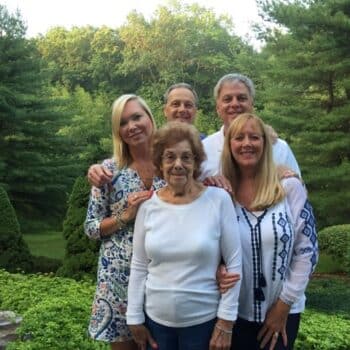Brian Bennett

To combat this anxiety, my wife suggested we use a whiteboard to help communicate more specifically with her. We began leaving her written messages, reminding her what day of the week it was, and who was coming to visit the next day. Using this communication method proved to be a godsend.
July 12, 2024
Brian Bennett is a former packaging executive and was a caregiver to his mother who lived with dementia.
My mother was diagnosed with dementia in 2007. Over the next decade, my sister, my brother, and I (along with our spouses) began taking turns caring for her. It proved challenging, given that each of us lived so far apart — in Minnesota, Massachusetts, and Virginia. We started out with a plan that meant Mom would stay with each of us for four months. I looked forward to my turn to care for her, and these visits always brought more happiness than sadness. Obviously, there were many challenges. The biggest was how to keep her safe at our home while we were at work. What started with a “Post-It note” strategy soon became a “signs taped up all over the house” strategy. Overall, Mom did well, but we knew that things were becoming increasingly difficult for her. As this disease slowly took away her short-term memory, even the simplest tasks became overwhelming.
After a year of trying to make it all work, we realized more caution was needed: we installed cameras in the house which allowed for two-way communication. Being able to actually see how Mom was doing and then calling her at regular intervals during the day was working. Using the signs posted all over the house, Mom was able to do simple things like making a coffee and operating the television. Keeping her safe was job number one. However, the effectiveness of our strategy began to fall apart rapidly, and soon ended with a trip to the ER: Mom had been crying in pain several nights in a row and it became apparent that something was terribly wrong. The hospital eventually diagnosed her pain as the result of a detached retina in her left eye. We were now facing our final option: placing her in an adult care facility close to my hometown in Virginia.
The first few months that Mom was in the long-term care facility were extremely stressful for her. Despite me, my wife, and my adult children making daily visits, she was always anxious and scared when those visits ended. To combat this anxiety, my wife suggested we use a whiteboard to help communicate more specifically with her. We began leaving her written messages, reminding her what day of the week it was, and who was coming to visit the next day. Using this communication method proved to be a godsend; soon, she’d refer to the whiteboard at the start of each visit and it was now clear to her that she still had loved ones who cared about her and she’d anticipate a family visitor each day.
Perhaps the greatest reward from communicating in this way was Mom’s capacity to still learn and, in her own way, remember. If we ever missed a visit due to some unforeseen circumstance, she’d always proudly point to that whiteboard and smile, saying: “I knew you were coming today.” To us it proved that the anticipation of our visit was just as valuable as the visit itself. The whiteboard message gave her peace knowing that somebody would be visiting her soon; even if we were a day later than the actual message stated. Mom passed away peacefully very early in the pandemic. Although we were unable to visit her for so many months in 2020, her facility graciously arranged a final visit to say goodbye. The one thing we know for sure, it wasn’t Covid that took her, it was a broken heart.
